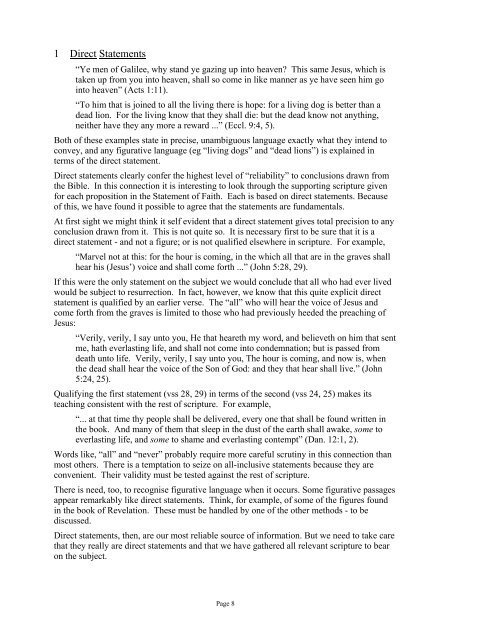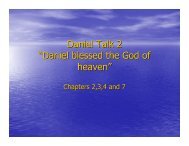Handout - Western Christadelphian Bible School
Handout - Western Christadelphian Bible School
Handout - Western Christadelphian Bible School
Create successful ePaper yourself
Turn your PDF publications into a flip-book with our unique Google optimized e-Paper software.
1 Direct Statements<br />
“Ye men of Galilee, why stand ye gazing up into heaven? This same Jesus, which is<br />
taken up from you into heaven, shall so come in like manner as ye have seen him go<br />
into heaven” (Acts 1:11).<br />
“To him that is joined to all the living there is hope: for a living dog is better than a<br />
dead lion. For the living know that they shall die: but the dead know not anything,<br />
neither have they any more a reward ...” (Eccl. 9:4, 5).<br />
Both of these examples state in precise, unambiguous language exactly what they intend to<br />
convey, and any figurative language (eg “living dogs” and “dead lions”) is explained in<br />
terms of the direct statement.<br />
Direct statements clearly confer the highest level of “reliability” to conclusions drawn from<br />
the <strong>Bible</strong>. In this connection it is interesting to look through the supporting scripture given<br />
for each proposition in the Statement of Faith. Each is based on direct statements. Because<br />
of this, we have found it possible to agree that the statements are fundamentals.<br />
At first sight we might think it self evident that a direct statement gives total precision to any<br />
conclusion drawn from it. This is not quite so. It is necessary first to be sure that it is a<br />
direct statement - and not a figure; or is not qualified elsewhere in scripture. For example,<br />
“Marvel not at this: for the hour is coming, in the which all that are in the graves shall<br />
hear his (Jesus’) voice and shall come forth ...” (John 5:28, 29).<br />
If this were the only statement on the subject we would conclude that all who had ever lived<br />
would be subject to resurrection. In fact, however, we know that this quite explicit direct<br />
statement is qualified by an earlier verse. The “all” who will hear the voice of Jesus and<br />
come forth from the graves is limited to those who had previously heeded the preaching of<br />
Jesus:<br />
“Verily, verily, I say unto you, He that heareth my word, and believeth on him that sent<br />
me, hath everlasting life, and shall not come into condemnation; but is passed from<br />
death unto life. Verily, verily, I say unto you, The hour is coming, and now is, when<br />
the dead shall hear the voice of the Son of God: and they that hear shall live.” (John<br />
5:24, 25).<br />
Qualifying the first statement (vss 28, 29) in terms of the second (vss 24, 25) makes its<br />
teaching consistent with the rest of scripture. For example,<br />
“... at that time thy people shall be delivered, every one that shall be found written in<br />
the book. And many of them that sleep in the dust of the earth shall awake, some to<br />
everlasting life, and some to shame and everlasting contempt” (Dan. 12:1, 2).<br />
Words like, “all” and “never” probably require more careful scrutiny in this connection than<br />
most others. There is a temptation to seize on all-inclusive statements because they are<br />
convenient. Their validity must be tested against the rest of scripture.<br />
There is need, too, to recognise figurative language when it occurs. Some figurative passages<br />
appear remarkably like direct statements. Think, for example, of some of the figures found<br />
in the book of Revelation. These must be handled by one of the other methods - to be<br />
discussed.<br />
Direct statements, then, are our most reliable source of information. But we need to take care<br />
that they really are direct statements and that we have gathered all relevant scripture to bear<br />
on the subject.<br />
Page 8







